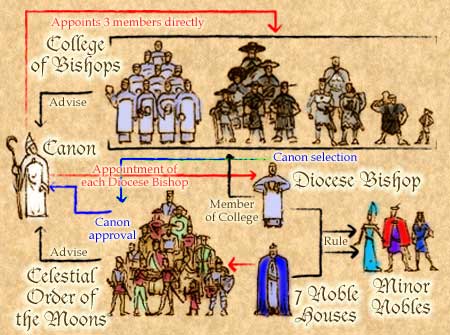![]() he Archclericy of Veluna is a
Theocracy ruled by the Canon of Veluna. Before we go into more depth lets get the definition of
"Theocracy" out in the open here.
he Archclericy of Veluna is a
Theocracy ruled by the Canon of Veluna. Before we go into more depth lets get the definition of
"Theocracy" out in the open here.
Theocracy: A government ruled by or subject to religious authority.
That definition defines how Veluna society works. With the Church of Rao guiding the country from above it lets religion slips into almost all facets of life in Veluna. Each Diocese has a Bishop attached to the noble house. Every town has a church somewhere in it. Most merchant and businesses either employ a priest or pay tribute to a church in some way.

Canon of Veluna: Head of College of Bishops. Ruler of the Country of Veluna. Roughly equivalent to a King with the College of Bishops and the Celestial Order of the Moons acting as his advisors. The Canon is selected by the College of Bishops and approved by the Celestial Order when the old Canon steps down or passes on. The College and Celestial Order may remove the Canon though this has never happened to date.
College of Bishops: A 21 person council that advises the Canon and maintains various religious functions in Veluna. The College is made up of the following: the Bishop of Rao from each of the seven dioceses, the Archbishop of Veluna City, the ruling council of the Church of Saint Cuthbert (5 members), the Triad of Heironeous, the High Priest of the Knights of Veluna, a representative of the elvish contingent, with the remaining three members are appointed by the Canon. The Council currently has the following religious breakdown: 10 Raoans, 6 Cuthbertines, 3 Heironeans, and 2 others.
Celestial Order of the Moons: This order consists of two representatives from each of the seven secular noble families, and a representative from the Viscounty of Verbobonc. Only the representatives from the seven noble house have any voting power; the representative from Verbobonc is merely there in an advisory capacity. The Celestial Order is presided over by the Archbishop of Veluna City though he serves no 'official' capacity on the order. Here are seven of the representatives, one of the two from each of the Noble Families.
| What is a Plar? |
|---|
|
"Plar" is the title held by the most powerful of the 7 ruling nobles in Veluna. It is not hereditary, but it is common for it to pass from father to son if the noble family retains it's power from generation to generation. The Plar of Veluna is the leader of the secular government. The secular government shares power with the religous government (each diocese is ruled by one bishop and one noble). The religous arm of government has the final say with the secular arm being more involved in day to day operations of the individual diocese and advising the religous arm in governing the nation. However, there is a check-and-balance system in place in that the secular arm has the ability to remove the canon (the head of the religous arm) from power. This critical power in the hands of the secular arm (ie nobility) gives them great influence and effectively limits how far the religous arm can go in suppressing the nobility. Originally an Oeridian term. |
Whitehale - Rachael Landis
Grayington - Matthew Sarneth
Valkurl - Joshua Borrington
Devarnish - Marcus Mori (Saint Cuthbert)
Kempton - Peter Basalle
Falsridge - Keri Grinish (Saint Cuthbert)
Lorrish - Sharis Jamorrie
Noble Houses: The head of each of the seven secular nobles houses form half of the governing body for each of the dioceses. The other half is the Bishop of Rao for that diocese. The eighth diocese is Veluna City which falls under the Canon's control (he appoints an archbishop to administer it.)
In most dioceses, the noble houses run them pretty much as they see in matters of state and economies. The bishop does not get involved unless it's a matter of church or national importance, though in some regions, the bishops try to take more control or simply do not get along with the nobles whatsoever. Each of the noble houses appoints a pair of members to the Celestial Order of the Moon to represent them in governmental matters. This is often a close family member for loyalty reasons.
Bishops of Rao: The Canon of Rao appoints a bishop to each of the Dioceses. He is the eyes and ears of the Council of Bishops and makes sure the Canon's will is carried out. This effectively pairs a high ranking officer of the state and the church in each diocese.
Minor Houses: Many minor noble houses exist in each diocese. They vary in size from new Barons with a few hundred acres to Dukes with 100s of square miles. They report to the nobles of the diocese they are in.

